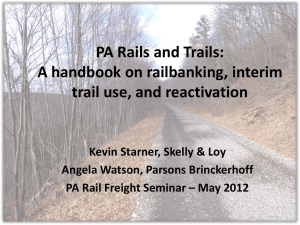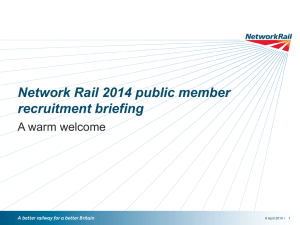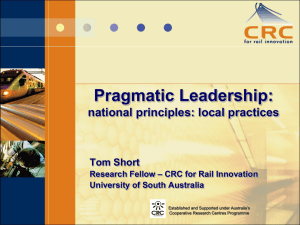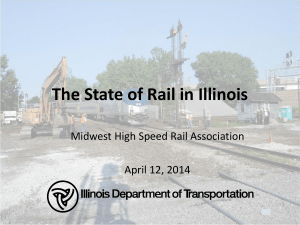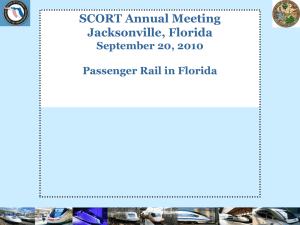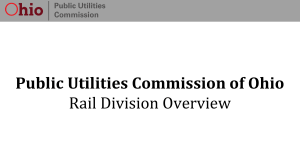(Rail Safety) Act 2010 - Department of Transport and Main Roads
advertisement
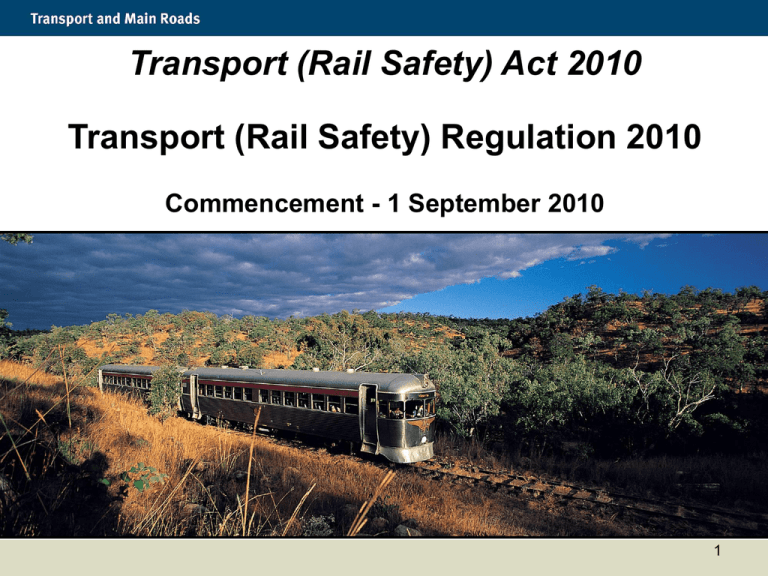
Transport (Rail Safety) Act 2010 Transport (Rail Safety) Regulation 2010 Commencement - 1 September 2010 1 What is going to remain the same? Majority of SMS requirements relatively unchanged • Management plans and programs - Security management plan - Emergency management plan - Health and fitness management program - Alcohol and drug management program - Fatigue management program 2 What is going to be different? • Rail Safety Duties • Reporting occurrences • Worker Competencies • Interface Agreements • Accreditation / Registration • Compliance / Enforcement • Private Sidings • New Fees • Relationship between WH&S and TRSA legislation 3 Rail Safety Duties New general duty requirements • Safety duties for rail operators, rail safety workers and rail contractors to: - Places responsibilities on each participant in the rail industry to ensure safety, so far as is reasonably practicable (SFAIRP). - Also need to ensure, SFAIRP, that things are safe if used as intended. - Applies to those conducting prescribed railway operations, such as the operation or movement of rolling stock on a railway track and an activity that affects safe operation or movement of rolling stock on a railway track. 4 Rail Safety Duties (2) When carrying out rail safety work, rail safety workers must: • Take reasonable care for their own safety and that of others. • Co-operate with the rail transport operator. • Not intentionally or recklessly interfere with or misuse anything provided by the rail transport operator in the interests of safety. • Not intentionally or recklessly place at risk the safety of another person on or in the immediate vicinity of rail infrastructure. 5 Transport (Rail Safety) Act 2010 and Workplace Health & Safety Act 1995 • Queensland WH&S law continues to apply to Queensland rail operators, in relation to duties around workplace safety. • If there is any overlap or conflict between the WH&S provisions and the Rail Safety provisions, the WH&S legislation will apply. • MoU - “Safety in the rail industry”, between WH&SQ and DTMR recognises both agencies’ responsibilities in regulating safety for rail. MoU details how the departments will work together in this regard. A copy of the MoU can be located at website: http://www.transport.qld.gov.au/Home/Safety/Rail/ 6 Worker competence New requirements for rail transport operators to prove worker Competence: • Rail safety workers must have competence to undertake the work. • Qualification or units of competence under the Australian Qualifications Framework. • Operators can require rail safety workers to undergo further training. • Record of the competence of each rail safety worker. • Rail safety workers must have identification that can be checked. • Two year transitional arrangement for worker competency and ID requirements. 7 Accreditation New requirements for the Regulator • A six-month time period for determining applications for accreditation, variation and exemption. • Requirement for the rail safety regulator to consult with other regulators where an applicant: - Is applying for accreditation in two or more jurisdictions. - Is already accredited in another jurisdiction. 8 Accreditation (2) Accreditation transition • Transitional arrangements for existing accreditations are in place for one year from the commencement of the new legislation. • Accredited rail transport operators will not be required to apply for new accreditation. • The rail safety regulator will conduct audits and inspections during the transitional period using a risk based approach to ensure that rail transport operators conform to the compliance requirements. 9 Private sidings There is a new focus on private rail sidings • Stand-alone private siding managers will not require accreditation. • Private sidings are subject to general duties, registration and other conditions. • Existing accredited rail transport operators with sidings need to remain accredited. • Rolling stock operators on private sidings are still required to be accredited. • Private siding managers required to pay annual fee for the registration. For each of the first five (5) private sidings - $110.00 each additional private siding - $70.00 • Three year transitional arrangements for private siding registration. 10 Interface Agreements • Interface agreement - still details each party’s responsibilities for managing interface risks: - • measures for managing the risks. evaluation, testing and, if necessary, revision of those measures the roles and responsibilities of each party to the agreement. how each party will monitor compliance. Rail and road infrastructure managers must now enter into interface agreements to manage risks at railway crossings: - Ensuring that risks are identified. Clarifying roles and responsibilities for managing the risks. Two year transitional arrangement for interface agreements. 11 Fees The new legislation includes the following fees: • An annual fee for the registration of private sidings For each of the first five (5) private sidings - $110.00 each additional private siding - $70.00 • Accreditation application fee For tourist and heritage railway operations - $1000.00 For railway operations which are the same or substantially the same in scope and nature to previously accredited operations under another jurisdiction’s corresponding legislation - $3000.00 and for all other applications - $8000.00 • Variation to accreditation Application No new fees 12 Reporting New rail safety reporting requirements for Safety Performance Reports • Rail transport operators must submit a safety performance report on an annual basis and within six months after the end of the period. • The safety performance report must include: - Description and assessment of the safety performance of railway operations. - Comments on any deficiencies and any relevant irregularities in operations. - Description of any initiatives undertaken in the reporting period, or proposed to be undertaken in the next reporting period. 13 Reporting New rail safety reporting requirements for notifying the rail safety regulator of changes affecting safety • Accredited rail transport operators must notify the rail safety regulator of change about: - • Any proposed changes/decisions. Events or changes relating to their railway operations. Examples of decisions, events or change that must be notified: - Safety critical element of existing rolling stock used in the railway operations - at least 28 days before the change is given effect. Safety standard for the design of rail infrastructure or rolling stock used in railway operations - at least 28 days before the standard is to be adopted. Rule or procedure, of a safe working system, relating to the carrying out of the railway operations - at least 28 days before the change is to be given effect. 14 Reporting New rail safety reporting requirements for notification of occurrences • If a notifiable occurrence happens on or in relation to a rail transport operator’s railway premises or railway operations, the operator must report the occurrence, within the prescribed period. • An operator must report the Category A notifiable occurrence immediately, followed by a written report within 72 hours. • All Category A occurrences must be investigated and a report provided to the Rail Safety Regulator. • An operator must report a Category B notifiable occurrence through a written report within 72 hours. 15 TIA MAJOR Within 2 hrs -Phone 1300 139 959 -Fax/email form F3222 Occurrence GENERAL Monthly ( along with Normalising data) -F3345 or -F3345xl TRSA CATEGORY A Immediately -Phone 1300 139 959 Within 72 hrs -Form F3345 (single occurrence) Or -Form F4830 CATEGORY B (multiple occurrence) Monthly Report -Form F4831 (normalising data) Annual Report -Form F4832 (estimated annual data) 16 No- blame investigations • The Rail Safety Regulator can conduct an independent investigation into a serious occurrence. • Investigation conducted to find cause and prevent reoccurrence. • Protections in legislation to protect persons from civil or criminal action so they can speak freely. 17 Compliance and Enforcement Compliance and enforcement options include a range of financial penalties for breaches of the new legislation. • Improvement notices • Issued when a breach of the legislation is detected. Will provide the date that compliance is to be achieved by. Is an offence not to comply. Prohibition notices Issued when a reasonable belief exists of an immediate risk to the safety of persons. Will require immediate cessation of the relevant activity. Will require certification from a rail safety officer that the risk has been remedied. Is an offence not to comply. 18 Compliance and Enforcement (2) • Embargo notices Embargo notices may be issued for things that cannot be seized. An embargo notice may be issued forbidding the use, movement, sale, leasing, transfer, deletion of information without approval. It is an offence for a person to knowingly do anything that is forbidden by an embargo. • Rail safety undertaking May be used in connection with a contravention of the legislation. If undertaking accepted, prosecution action cannot be taken for the breach. Must address the matters which have given rise to the breach. The description of deliverables will be precise and detailed. Regulator may apply to the court to have the undertaking enforced if failure to comply. 19 The Regulatory Environment Criminal Behaviour Unwilling to comply Pathological Safety Culture Enforced Compliance Voluntary Compliance Best Practice Comply as required to Willing to comply Seeks to be best Reactive Safety Culture Bureaucratic Safety Culture “By the book” organisation Information is acted on Well established information flow Messengers are encouraged “Cut & Paste” procedures Gaps in safety management Change is top-down Shirk responsibility Dysfunctional in a dynamic environment Information blocked or controlled Respond when things go wrong Difficult to achieve positive change Responsibilities are delegated Cover up failure Generative Safety Culture Emphasis on achievement not process Actively seek information Failure is a concern Shirk responsibility No employee/ employer bridging Proactive Safety Culture Do not identify systemic failures Shared responsibility New ideas are considered Continuous evaluation Paperwork & meetings, meetings… Amenable to improvement Identify systemic failures Response Enforcement Strategies Co-regulatory Strategies 20 Compliance Strategies Response Co-regulatory Strategies Education Audits Conditions Notices Prosecution Cancellation Enforcement Strategies 21 Audit program • The rail safety regulator will conduct audits of each rail transport operators safety management systems. • Audit program is risk based. • Audit may identify non compliance with rail safety legislation. • Rail transport operators will be provided an opportunity to correct any instance of detected non compliance. 22 Inspections • The rail safety regulator may conduct an inspection in respect to a notifiable occurrence. • The inspection will focus on public safety matters. • The inspection may identify non-compliance with rail safety legislation. • Rail transport operators will be provided an opportunity to correct any instance of detected non compliance. 23 Supporting National Guidelines • Meaning of SFAIRP • Preparation of an SMS • Compliance and Enforcement • Fatigue Management • Uniform Business Rules • T&H Guidance • Notification of change • Rail Contractors • Safety Performance Report • Definition of Private Sidings 24 Other useful information Legislation - Transport (Rail Safety) Act 2010 - Transport (Rail Safety) Regulation 2010 You can obtain a copy of these documents through the Office of the Queensland Parliamentary Counsel. Website: www.legislation.qld.gov.au Guidelines - National Transport Commission (NTC) Website: www.ntc.gov.au - Rail Safety Regulator Panel (RSRP) Website: http://www.rsrp.asn.au/ 25 Other useful information (2) Factsheets • A comprehensive list of Factsheets are available for you to access. Website: www.tmr.qld.gov.au Frequently Asked Questions • A ‘Frequently Asked Questions’ paper is available for you to access. Website: www.tmr.qld.gov.au 26

